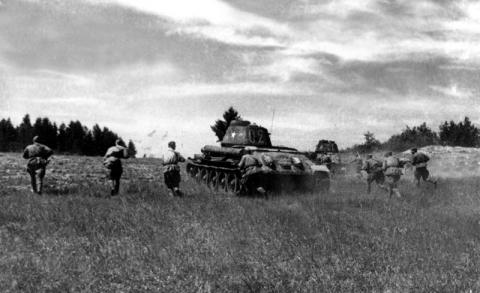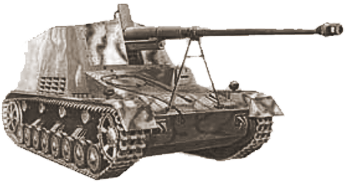August, 1942 - The Red Army vs. German Army Group Center

The 1941-45 war fought between Germany and Russia ranks as the bloodiest war fought in human history. Yet, in spite of this historically significant and horrific distinction, modern descriptions of the war often remain grounded in myth or distortion. For instance, typical accounts of the fighting on Germany's Eastern Front during August of 1942 focus almost exclusively on the infamous "Road to Stalingrad." This is in spite of the reality that virtually the entire German-Soviet front sustained vicious and sustained periods of combat during the summer of 1942. One merely needs to look at the repeated assaults launched by the Soviet Kalinin and Western Fronts against the German held Rzhev Salient, from July to September 1942, to recognize the mistake made by past historians in ignoring the frontwide fighting in reality marking the Russian summer of 1942.
In the summer of 1942 Army Group Center defended approximately 450 straight-line miles between Orel, in the south, and Lake Il'men, in the north. However, the frontage defended by the Army Group actually stretched much longer in reality. The prime reason for these additional defensive requirements stemmed from two massive salient's and one smaller salient; all of which abutted each other in the north-middle portion of Army Group Center's area of operations and southern portion of Army Group North's area of operations. The Red Army's Kalinin Front held one salient around the town of Toropets. This salient extended 200 miles in width and 200 miles west into German positions. German forces bracketed the Toropets salient in the other two salient's most responsible for extending the front lines. To the south of Toropets Army Group Center held a salient just as large, but pointed east toward Moscow. The cities of Rzhev and Vyazma served as the primary population centers in this salient. Crucially, the highway to Moscow ran east from the German lines, and thus the German positions, defended by the German Ninth Army, represented a prime jumping off point for a renewed assault on the Soviet capital. In addition to the Rzhev salient, Army Group North's Sixteenth Army occupied a smaller salient at Demyansk - to the north of the Soviet held positions at Toropets.
Heavily forested terrain defined the entire region, and helped bolster the extensive defensive fortifications built by the otherwise vulnerably extended German and Soviet armies. The Russians were determined to eliminate the threat to Moscow, and on July 16th Stavka ordered Zhukov's Western and Konev's Kalinin Fronts to strike the German salient at Rzhev. On July 30th Konev's Front hit the Germans first, making initial gains, but then brought to a standstill by the arrival of German reserves. On August 4th Zhukov struck, blew open the German lines and committed his mobile group to exploit the penetration. The exploitation forces included the 6th and 8th Tank Corps and 2nd Guards Cavalry Corps; with this potent assembly of men and machines including some 600 tanks. Approximately half the armor was made up of powerful T-34s and KV-1 medium and heavy tanks outclassing most German panzers fielded by the Ninth Army. The twin Soviet assaults quickly put the entire German salient under enormous stress, and threatened to unhinge Army Group Center's defensive front.
Army Group Center's commander, Gunther Kluge, demanded reinforcements from OKH. However, Hitler and Halder, engrossed in Army Group A and B's drives through Southern Russia, failed to recognize the seriousness of the Soviet threat. Moreover, they had already ordered Army Group Center to conduct an offensive of its own and, even though Stavka had beat them to the punch, still insisted Kluge follow through on the original plan. Thus, as Ninth Army fought for its life the 200 tanks and assault guns in the 9th, 11th, 17th and 20th Panzer Divisions and 25th Motorized Division, all from the German Second Panzer Army, slammed into Soviet positions 120 miles to the south of Ninth Army's struggles. The Second Panzer Army's attack accomplished next to nothing, and then was forced to fight off a Soviet counterstroke launched by the Western Front's reinforced 610 tank strong 3rd Tank Army, 16th Army - with 100 tanks and 61st Army. In spite of the less than full commitment of German armored reserves, the Ninth Army had received enough reinforcements that the Germans, with the help of Zhukov's mistaken decision to redirect sizeable forces, contained the assault on the 9th Army and stopped the Western Front's counterstroke. The German divisions involved in this effort decimated Soviet armored ranks, destroying 500-700 tanks even as Army Group Center's Third Panzer Army, fought off yet another Soviet assault, launched by the Soviet 33rd Army.
In addition to the losses in machines, the primary attacking Soviet armies involved in these offensives, the 20th, 29th, 30th, 31st, 39th, and 41st suffered appalling casualties. The six Soviet armies began August of 1942 with a combined strength of 526,300 men. By September's end, these six armies had lost 344,000 men killed, wounded, missing, or captured; these figures included replacements lost as casualties during this period. Meanwhile, in July the Northwestern Front's 11th and 27th Armies had attacked and went nowhere against Army Group North's Sixteenth Army in its salient at Demyansk. In spite of this defeat, Stavka ordered up an August offensive featuring the 11th Army and 1st Shock Army. The German Sixteenth Army also turned aside this assault as it degenerated into a ten day bloody mess that measured its advance in yards. Finally the Red Army called the offensive off, given the stiff resistance it had encountered- in particular from the 3rd SS Motorized Division.
The intense combat marking Army Group North and Center's fronts in August of 1942, only partially documented here, demonstrates how characteristic descriptions regarding the German-Soviet war, focused largely on events initiated by German Army Group South in 1942, miss quite a bit and contribute mightily to many of the most pernicious myths distorting our understanding of the Second World War.
by Steven Douglas Mercatante



Post new comment